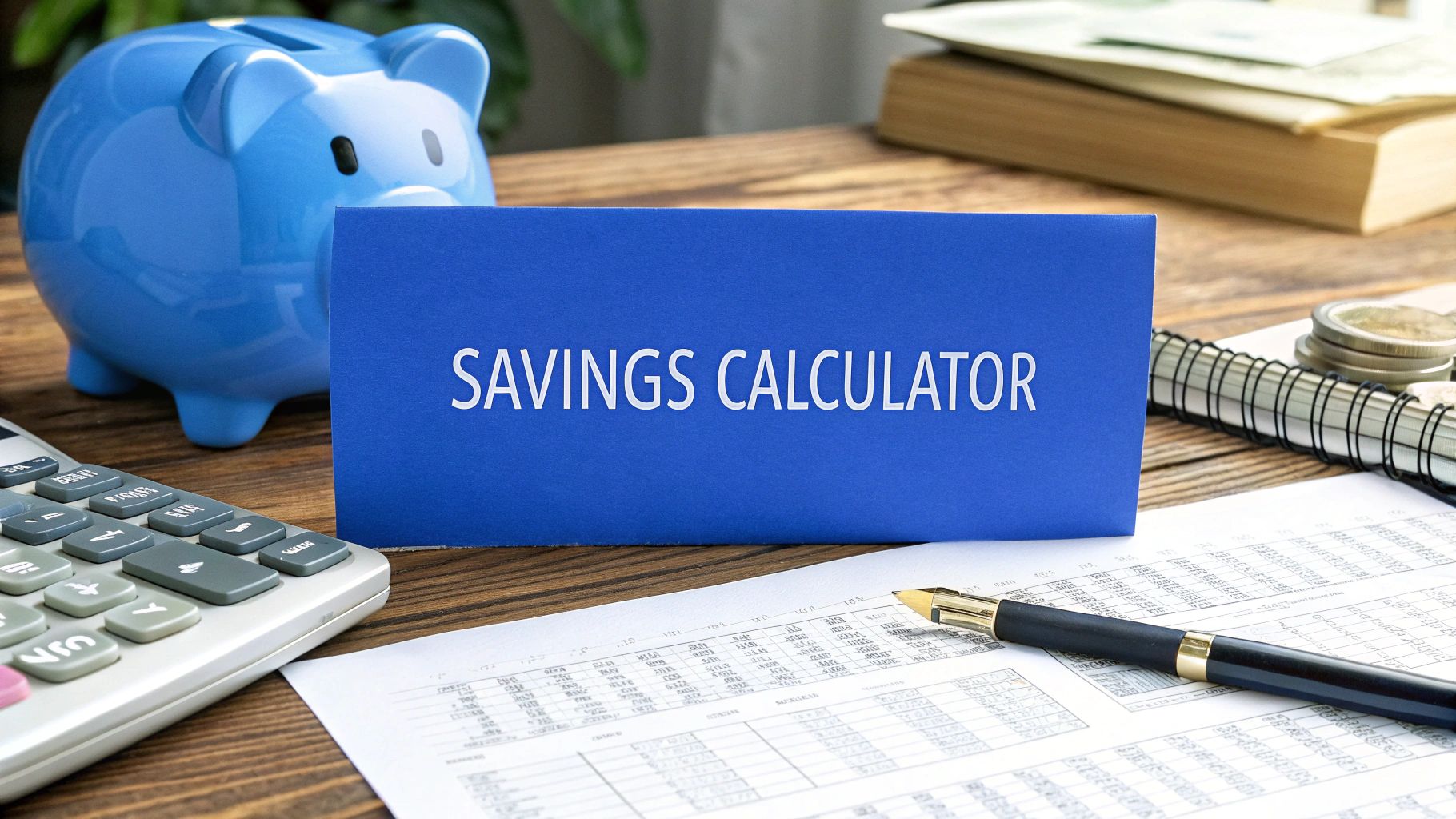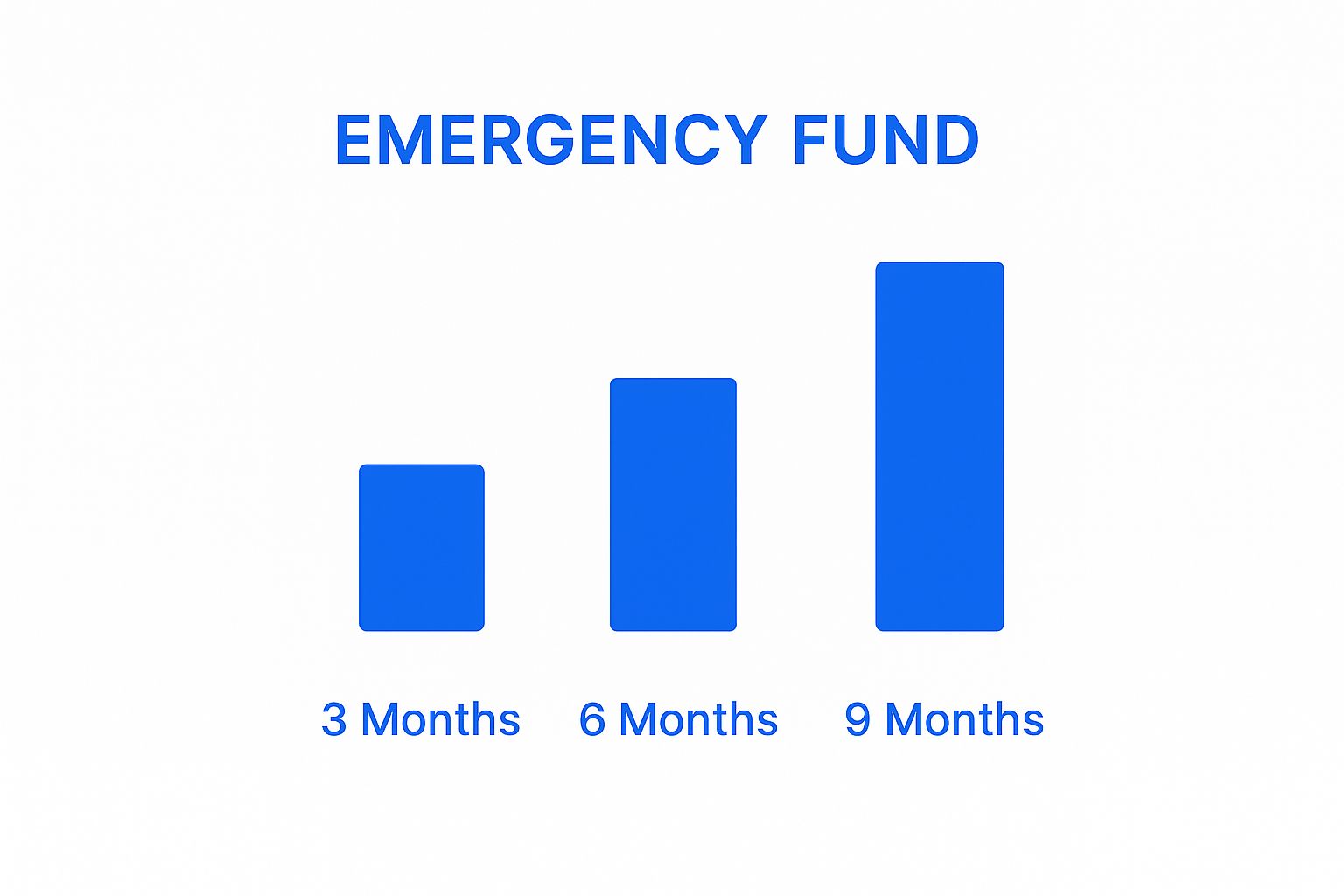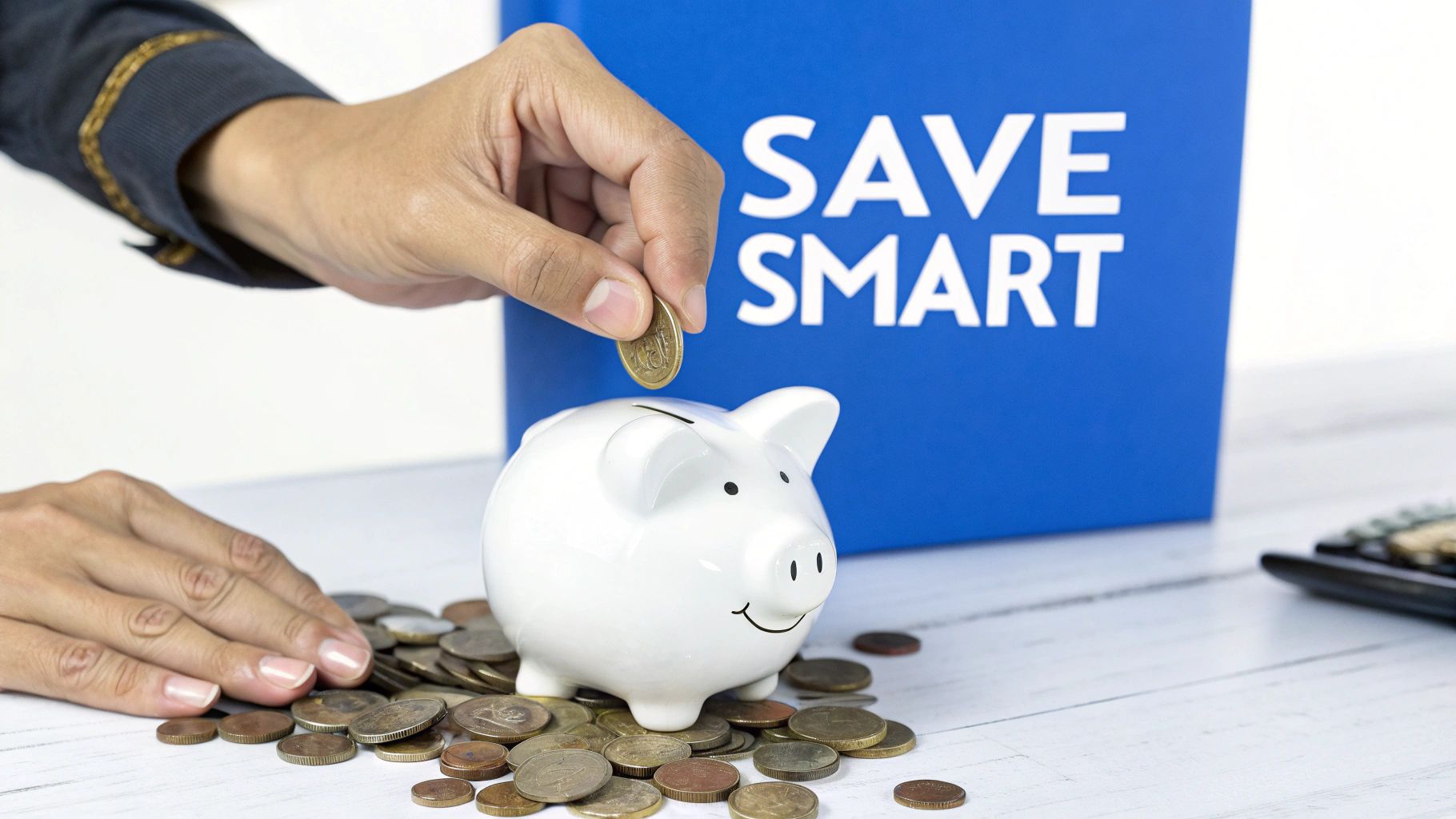Our Marketing Team at PopaDex
Emergency Savings Calculator Your Financial Safety Net

Ever wondered exactly how much you should have tucked away for a rainy day? An emergency savings calculator is a straightforward tool that answers that question. It tallies up your must-pay monthly bills and multiplies that number by 3 to 6 months to give you a clear, personalized savings target. This isn’t just a number; it’s your financial safety net.
Why an Emergency Fund Is Your Financial Foundation

Life has a knack for throwing curveballs. A sudden car repair, an unexpected trip to the ER, or a surprise layoff can throw anyone’s finances into chaos. This is precisely where an emergency fund proves its worth, acting as a personal buffer against those financial shocks.
Honestly, it’s less of a “nice-to-have” and more of a non-negotiable pillar of good financial health.
Having this cash cushion provides something more valuable than money: peace of mind. When a crisis hits, you need to focus on solving the problem, not scrambling to figure out how to pay for it. An emergency fund keeps you from making rash decisions, like racking up high-interest credit card debt or, even worse, raiding your retirement accounts.
The Sobering Reality of Financial Preparedness
Unfortunately, a lot of people are flying without this critical safety net. The latest data reveals a pretty startling gap in how prepared Americans really are. According to Bankrate’s Annual Emergency Savings Report, only 46% of U.S. adults have enough stashed away to cover three months of living expenses.
Even more concerning, a staggering 24% have no emergency savings at all, leaving them completely exposed when—not if—an emergency strikes. You can dig into the specifics in the full emergency savings report on Bankrate.com.
These numbers paint a picture of widespread vulnerability. Without savings, a single unexpected bill can kickstart a downward spiral of debt and stress.
An emergency fund isn’t about being pessimistic; it’s about building a foundation that lets you handle life’s inevitable bumps without derailing your long-term goals.
It’s More Than Just Covering Bills
The value of an emergency fund goes way beyond just paying for surprise costs. It empowers you to make better life decisions from a position of strength, not desperation.
Think about these real-world benefits:
- Career Flexibility: It gives you the breathing room to walk away from a toxic job without having another one lined up.
- Negotiating Power: When your car dies, you can shop around for a fair repair quote instead of being forced to take the first one you get.
- Mental Well-being: Simply knowing you have that buffer can dramatically reduce financial anxiety, which has a huge impact on your overall quality of life.
Ultimately, the goal is to build a fund that provides genuine security. Using an emergency fund calculator is the first practical step toward figuring out what that security looks like for you and creating a concrete plan to get there.
How to Calculate Your Personal Savings Goal

Forget generic advice that tells you to save a random number. Your emergency fund isn’t some magic figure pulled from a hat; it’s a number deeply rooted in your personal financial reality. Figuring out that number is the first step to moving from vague worry to a concrete, achievable target.
The first move is to get brutally honest about your essential monthly expenses. These are the bills you’d have to pay no matter what—the absolute non-negotiables if your income suddenly vanished.
This isn’t about your total monthly spending. It’s about stripping everything down to the bare necessities required to keep your life afloat.
Identifying Your Essential Monthly Expenses
To find your number, you have to separate the “must-haves” from the “nice-to-haves.” The goal is to tally up only the critical bills that keep the lights on and a roof over your head.
Here’s what typically falls into the essential category:
- Housing: Your mortgage or rent payment.
- Utilities: Electricity, water, natural gas, and essential internet.
- Food: Your realistic monthly grocery budget—not dining out.
- Insurance: Health, auto, and home or renters insurance premiums are critical.
- Transportation: Car payments, fuel, or public transit needed for job hunting.
- Minimum Debt Payments: The bare minimum you must pay on student loans or credit cards to avoid default.
Notice what’s missing? Things like streaming services, gym memberships, and that daily coffee run are paused during a true emergency. An emergency savings calculation is all about survival-mode spending.
Before we move on, take a moment to categorize your own spending. This worksheet can help you get a clear, honest total for your essential monthly costs.
Worksheet for Essential vs Discretionary Monthly Expenses
| Expense Category | Is this Essential? | Your Monthly Cost | Notes/Examples |
|---|---|---|---|
| Housing | Yes | Mortgage/Rent | |
| Utilities | Yes | Electric, Water, Gas, Internet | |
| Groceries | Yes | Food for home, not restaurants | |
| Transportation | Yes | Car Payment, Gas, Public Transit | |
| Insurance | Yes | Health, Auto, Home/Renters | |
| Debt Minimums | Yes | Student Loans, Credit Cards | |
| Streaming | No | Netflix, Spotify, etc. | |
| Dining Out | No | Restaurants, Coffee Shops | |
| Gym Membership | No | Fitness classes, subscriptions | |
| Shopping | No | Clothing, hobbies, non-essentials |
Once you’ve filled this out and totaled the “Yes” column, you have the single most important number for this entire process. It’s also a powerful data point to track within your larger financial picture. You can see how this fits into your overall financial health with our net worth calculator.
From Monthly Costs to Your Final Goal
With your essential monthly expense total in hand, the next step is simple multiplication. You just need to decide on your savings timeline—how many months of security do you want to build?
Financial planners typically suggest having an emergency fund that can cover at least three to six months of living expenses. This isn’t arbitrary; it’s based on real-world data about how long it might take to find a new job or recover from an unexpected event.
The calculation is simple but powerful: (Your Essential Monthly Expenses) x (Number of Months to Cover) = Your Emergency Fund Goal
Let’s make this real. Imagine a freelancer whose essential monthly bills—rent, utilities, groceries, etc.—add up to $2,500. Because their income can be unpredictable, they decide a six-month buffer would give them true peace of mind.
Their calculation is straightforward: $2,500 (monthly expenses) x 6 (months) = $15,000.
Suddenly, $15,000 is their concrete target. It’s no longer an abstract concept but a specific number to work toward.
Now consider a dual-income family with stable jobs. Their essential expenses are higher, say $4,000 a month. With two incomes, they might feel comfortable with a three-month fund. For them, the goal would be $4,000 x 3 = $12,000.
This simple process demystifies the entire concept, turning a source of anxiety into a personalized and actionable goal.
How Many Months of Savings Do You Actually Need?
That old “three to six months of expenses” rule is a decent starting point, but let’s be honest—it’s not a one-size-fits-all prescription. The right number for your emergency fund depends entirely on your life, your comfort with risk, and where you are on your financial journey. A generic calculator can give you a baseline, but true financial security comes from fine-tuning that number.
Your goal is to build a buffer that genuinely matches the volatility of your life. For a dual-income couple with stable, in-demand jobs, a three-month fund might feel rock-solid. But if you’re the sole provider, a freelancer with a fluctuating income, or dealing with chronic health issues, that same three-month cushion could feel terrifyingly thin.
This image breaks down the most common emergency fund targets.

Each level offers a different degree of protection, scaling from basic coverage to a robust safety net designed for more unpredictable lives.
Tailoring Your Savings Target to Your Risk Level
To get beyond the basic guidelines, you need to do a quick personal risk assessment. This just means taking an honest look at your income stability, job security, and who relies on you. The more potential financial curveballs you face, the bigger your emergency fund should be.
Here are the big factors to consider when deciding between a three, six, or even a nine-month goal:
- Income Stability: Is your paycheck a predictable salary, or do you live on commissions, freelance gigs, or seasonal work? An irregular income stream is a strong argument for a larger fund—think six months or more.
- Job Security: How stable is your industry? If you work in a volatile field or a role known for layoffs, a bigger fund gives you a much longer runway to find a new job without panicking.
- Dependents and Obligations: Are you single and only responsible for yourself? Or do you have a partner, kids, or even aging parents who depend on you financially? The more people who rely on your income, the stronger your safety net needs to be.
- Health: Do you or a family member have a chronic health condition? Unexpected medical bills or needing to take unplanned time off work can drain a small fund fast. A larger fund can absorb these shocks without derailing your entire financial plan.
A bigger emergency fund isn’t about being pessimistic; it’s a strategic tool. It buys you time and options, letting you handle a crisis from a position of strength, not desperation.
Finding Your Savings Target Based on Personal Risk
Everyone’s situation is unique, so let’s break down how different life circumstances might translate into a savings target. This isn’t a rigid formula, but it provides a framework to help you think through your own needs.
| Your Situation | Risk Level | Recommended Savings Target |
|---|---|---|
| Dual-income household, stable jobs, low debt, good health | Low | 3 Months |
| Single income earner, stable job, some debt | Moderate | 3-6 Months |
| Gig worker or freelancer with variable income | High | 6+ Months |
| Sole provider for dependents, work in a volatile industry | High | 6-9 Months |
| Have chronic health issues or a high-deductible health plan | Moderate to High | 6+ Months |
Use this table to find the scenario that most closely matches your own. It’s a great way to gut-check the standard advice and land on a number that actually lets you sleep at night.
Age and Financial Preparedness
Interestingly, how prepared people are for an emergency often lines up with their age, as both responsibilities and incomes tend to grow over time. The Federal Reserve’s recent Survey of Household Economics and Decisionmaking found that only 55% of American adults had enough savings to cover three months of essential expenses.
The generational gap was stark: just 36% of adults aged 18-29 were prepared, compared to a much more resilient 72% of those 60 and older. You can discover more about these economic findings from the St. Louis Fed.
This data really drives home the point that financial resilience is something you build over a lifetime. By thoughtfully assessing your personal situation and using a calculator as your guide, you can set a target that provides the right level of protection for you, right now.
Practical Ways to Build Your Fund Faster
Alright, so you’ve used the emergency fund calculator and now you have the number. Seeing that target can feel both empowering and a little intimidating. What now?
The secret isn’t about making massive, painful sacrifices overnight. It’s about building small, sustainable habits that snowball into a serious financial cushion. Think of it less like a sprint and more like building a fortress, one brick at a time.
The single most effective thing you can do is automate your savings. This is the old “pay yourself first” mantra, and it works for a reason. Instead of trying to save whatever is left over at the end of the month (which is often nothing), you treat your savings contribution like a non-negotiable bill.
Set up an automatic transfer from your checking to your savings account for the day you get paid. Even if you start with just $25 per paycheck, you’re building a powerful habit and creating momentum. You’re making saving effortless.
Capitalize on Financial Windfalls
Every so often, a chunk of cash you weren’t expecting lands in your lap. These windfalls are a golden opportunity to leapfrog toward your goal. The temptation is to see it as “fun money,” but a smarter move is to funnel it directly into your emergency fund.
What counts as a windfall?
- Tax Refunds: The average tax refund is often over $3,000. For many, that’s an instant starter emergency fund.
- Work Bonuses: That performance bonus is the perfect candidate to send straight to savings before you even miss it.
- Cash Gifts: Birthday or holiday money might seem small, but it all adds up.
- Selling Your Stuff: That old bike in the garage or those clothes you never wear? A quick clear-out can easily net you a few hundred dollars.
By dedicating at least 50% of any unexpected cash to your emergency fund, you can shave months—or even years—off your savings timeline without touching your regular budget.
Find Hidden Cash with a Spending Audit
Most of us have budget “leaks”—those small, recurring expenses that fly under the radar but drain a surprising amount of cash. A quick spending audit is like a treasure hunt for money you didn’t know you had.
Grab your last three months of bank and credit card statements and look for these common culprits:
- Subscription Creep: Tally up all those streaming services, apps, and memberships you’re paying for. Be honest. If you haven’t used it in months, cancel it.
- Negotiable Bills: Give your cable, internet, and cell phone providers a call. Ask for the retention department and see if they can offer you a better rate or match a competitor’s promotion. You’d be surprised how often this works.
- “Phantom” Spending: Add up all the daily coffees, lunches out, and vending machine runs. Seeing the monthly total in black and white can be a real eye-opener and motivate you to pack a lunch a few more times a week.
Finding an extra $50 or $100 a month might not sound like a game-changer, but that’s $600 to $1,200 a year. That’s a massive boost to your emergency savings, found without having to get a second job.
When you combine automation with smart use of windfalls and a little spending cleanup, you’re attacking your goal from multiple angles. This approach makes the whole process feel faster and way less painful, turning that calculated number into a real asset that buys you priceless peace of mind.
Where to Keep Your Emergency Savings

Once you’ve nailed down your savings target, the next question is a big one: where should this money actually live? The answer comes down to two non-negotiable principles. Your emergency fund absolutely must be safe from risk and easy to get to when you need it most.
This isn’t money you can afford to gamble with. Its entire job is to be there, stable and ready, when a crisis hits. That immediately rules out parking it in the stock market or other investments where its value could tank right when you need to cash out.
High-Yield Savings Accounts: The Top Choice
For most people, the clear winner is a high-yield savings account (HYSA). These accounts, usually offered by online banks, are the perfect blend of safety and growth. First, they are FDIC-insured up to $250,000, which means your principal is completely protected.
At the same time, HYSAs offer interest rates that blow traditional brick-and-mortar savings accounts out of the water. While your neighborhood bank might be paying a measly 0.01% APY, it’s common for HYSAs to offer rates 40 to 50 times higher. This lets your fund grow passively over time, helping it keep up with inflation.
An HYSA makes your money work for you without exposing it to market risk. It’s the perfect balance of safety, accessibility, and growth for an emergency fund.
Keeping this money in a separate account from your daily checking is also a smart psychological move. That little bit of friction—having to initiate a transfer—can be just enough to stop you from dipping into your fund for non-emergencies, like a tempting weekend sale or a last-minute dinner out.
Other Options to Consider
While HYSAs are the front-runner, it’s good to know about a couple of other options, even if they often come with trade-offs.
- Money Market Accounts: These are very similar to savings accounts and are also FDIC-insured. They sometimes come with a debit card or check-writing privileges, which adds a layer of convenience. However, their interest rates are often just okay—comparable to or even slightly lower than the top HYSAs.
- Traditional Savings Accounts: The main selling point here is convenience, especially if you want to keep all your money at a single bank. The downside is a big one: the interest rates are typically abysmal. Over time, your money actually loses its purchasing power to inflation.
The ultimate goal is to pick an account that keeps your fund liquid and secure. The interest you earn is a fantastic bonus, but safety comes first. If you’re curious about how your income compares to others in your field, check out our Salary Comparison Calculator. It’s a great way to see where you stand financially.
Common Questions About Your Emergency Fund
Once you’ve run the numbers and set a target, the real-world questions start popping up. It’s one thing to have a savings goal, but it’s another to know exactly how—and when—to use that money.
Let’s clear up the common gray areas so you can manage your new safety net with total confidence.
The first question is always the big one: what actually counts as an emergency? The answer has less to do with the price tag and more to do with the situation itself.
A true emergency is any expense that is unexpected, urgent, and necessary. We’re talking about a surprise job loss, a burst pipe flooding your kitchen, or a medical bill your insurance decided not to cover. It’s definitely not for a last-minute vacation deal or a new gadget you’ve been eyeing.
Here’s a simple test. Before touching your fund, ask yourself: “If I don’t pay for this right now, will there be serious, negative consequences?” If the answer is a hard ‘yes,’ you’re almost certainly in emergency territory.
So, What Happens After I Use My Fund?
Dipping into your emergency savings can feel like a step back, but it’s really a win. You used the money for its exact purpose—that’s a victory for your financial planning. Take a moment to appreciate that the system worked.
Now, what’s next? Your top financial priority becomes rebuilding that fund.
This means it’s time to temporarily hit pause on other non-essential savings goals, like extra contributions to your investment accounts (beyond any employer match). Rework your budget to see where you can make some short-term cuts and redirect every spare dollar toward getting your safety net back to full strength.
Should I Save First or Pay Off High-Interest Debt?
This is the classic financial chicken-or-the-egg dilemma. Should you throw everything at high-interest debt, or build your savings first? The smartest path is usually a hybrid approach.
Going all-in on debt without any savings is risky. One unexpected car repair could force you right back into credit card debt, erasing all your hard work.
Here’s a more effective strategy that balances both needs:
- Build a “starter” emergency fund first. Don’t aim for the full six months right away. Just focus on getting a small buffer of $1,000 to $2,000 in the bank. This small cushion is enough to handle minor bumps in the road without derailing your debt payoff plan.
- Then, attack high-interest debt aggressively. With your starter fund in place, you can shift your full focus to wiping out expensive debt like credit cards. Throw every extra dollar at it until it’s gone.
Once that high-interest debt is a thing of the past, you can pivot back and build your emergency fund up to your full three-to-six-month target. This method gives you a critical safety net while you work on becoming completely debt-free.
Ready to gain complete clarity over your finances and track your emergency savings goals with ease? PopaDex consolidates your entire financial life into one intuitive dashboard, so you can watch your net worth grow in real time. Start your free trial today at PopaDex.com and take the first step towards true financial control.